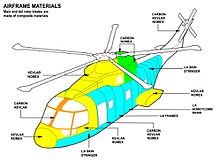Design and construction

Aircraft are designed according to many factors such as customer and manufacturer demand, safety protocols and physical and economic constraints. For many types of aircraft the design process is regulated by national airworthiness authorities.
The key parts of an aircraft are generally divided into three categories:
- The structure comprises the main load-bearing elements and associated equipment.
- The propulsion system (if it is powered) comprises the power source and associated equipment, as described above.
- The avionics comprise the control, navigation and communication systems, usually electrical in nature.
Structureedit
The approach to structural design varies widely between different types of aircraft. Some, such as paragliders, comprise only flexible materials that act in tension and rely on aerodynamic pressure to hold their shape. A balloon similarly relies on internal gas pressure, but may have a rigid basket or gondola slung below it to carry its payload. Early aircraft, including airships, often employed flexible doped aircraft fabric covering to give a reasonably smooth aeroshell stretched over a rigid frame. Later aircraft employed semi-monocoque techniques, where the skin of the aircraft is stiff enough to share much of the flight loads. In a true monocoque design there is no internal structure left.
The key structural parts of an aircraft depend on what type it is.
Aerostatsedit
Lighter-than-air types are characterised by one or more gasbags, typically with a supporting structure of flexible cables or a rigid framework called its hull. Other elements such as engines or a gondola may also be attached to the supporting structure.
Aerodynesedit
Heavier-than-air types are characterised by one or more wings and a central fuselage. The fuselage typically also carries a tail or empennage for stability and control, and an undercarriage for takeoff and landing. Engines may be located on the fuselage or wings. On a fixed-wing aircraft the wings are rigidly attached to the fuselage, while on a rotorcraft the wings are attached to a rotating vertical shaft. Smaller designs sometimes use flexible materials for part or all of the structure, held in place either by a rigid frame or by air pressure. The fixed parts of the structure comprise the airframe.
Avionicsedit
The avionics comprise the aircraft flight control systems and related equipment, including the cockpit instrumentation, navigation, radar, monitoring, and communications systems.
Comments
Post a Comment